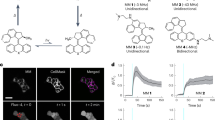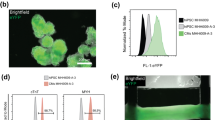Abstract
Electrical stimulation is the standard technique for exploring electrical behavior of heart muscle, but this approach has considerable technical limitations. Here we report expression of the light-activated cation channel channelrhodopsin-2 for light-induced stimulation of heart muscle in vitro and in mice. This method enabled precise localized stimulation and constant prolonged depolarization of cardiomyocytes and cardiac tissue resulting in alterations of pacemaking, Ca2+ homeostasis, electrical coupling and arrhythmogenic spontaneous extrabeats.
This is a preview of subscription content, access via your institution
Access options
Subscribe to this journal
Receive 12 print issues and online access
$259.00 per year
only $21.58 per issue
Buy this article
- Purchase on Springer Link
- Instant access to full article PDF
Prices may be subject to local taxes which are calculated during checkout



Similar content being viewed by others
References
Wikswo, J.P. Jr., Lin, S.F. & Abbas, R.A. Biophys. J. 69, 2195–2210 (1995).
Merrill, D.R., Bikson, M. & Jefferys, J.G. J. Neurosci. Methods 141, 171–198 (2005).
Gillis, A.M., Fast, V.G., Rohr, S. & Kleber, A.G. Circ. Res. 79, 676–690 (1996).
Knisley, S.B., Trayanova, N. & Aguel, F. Biophys. J. 77, 1404–1417 (1999).
Nagel, G. et al. Proc. Natl. Acad. Sci. USA 100, 13940–13945 (2003).
Boyden, E.S., Zhang, F., Bamberg, E., Nagel, G. & Deisseroth, K. Nat. Neurosci. 8, 1263–1268 (2005).
Nagel, G. et al. Curr. Biol. 15, 2279–2284 (2005).
Gradinaru, V. et al. J. Neurosci. 27, 14231–14238 (2007).
Kolossov, E. et al. J. Exp. Med. 203, 2315–2327 (2006).
Okabe, M., Ikawa, M., Kominami, K., Nakanishi, T. & Nishimune, Y. FEBS Lett. 407, 313–319 (1997).
Maltsev, V.A., Wobus, A.M., Rohwedel, J., Bader, M. & Hescheler, J. Circ. Res. 75, 233–244 (1994).
Roell, W. et al. Nature 450, 819–824 (2007).
Salama, G. et al. J. Membr. Biol. 208, 125–140 (2005).
O'Rourke, B. et al. Circ. Res. 84, 562–570 (1999).
Bers, D.M. Annu. Rev. Physiol. 70, 23–49 (2008).
Wobus, A.M., Wallukat, G. & Hescheler, J. Differentiation 48, 173–182 (1991).
Sasse, P. et al. J. Gen. Physiol. 130, 133–144 (2007).
George, S.H. et al. Proc. Natl. Acad. Sci. USA 104, 4455–4460 (2007).
Nagy, A. et al. Development 110, 815–821 (1990).
Acknowledgements
We thank K. Deisseroth (Stanford University) for providing the pcDNA3.1/hChR2(H134R)-EYFP plasmid, A. Nagy and M. Gertsenstein (Mount Sinai Hospital, Toronto) for providing the G4 mouse embryonic stem cell line, H. Begerau (University Bonn) for writing the frequency analysis software, and F. Holst and M. Czechowski for technical assistance. This work was supported by grants from the Bonfor program (Medical Faculty, University Bonn) (to T. Bruegmann and P.S.), Deutsche Forschungsgemeinschaft (FL 276/3-3) and European Community Network of Excellence (LSHB-CT-2005-512146).
Author information
Authors and Affiliations
Contributions
T. Bruegmann, B.K.F. and P.S. designed the study and prepared the manuscript. T. Bruegmann, D.M., T. Beiert and P.S. performed experiments and analyzed data. C.J.F. and M.H. generated the transgenic mice.
Corresponding author
Ethics declarations
Competing interests
The authors declare no competing financial interests.
Supplementary information
Supplementary Text and Figures
Supplementary Figures 1–6, Supplementary Note 1 (PDF 968 kb)
Supplementary Video 1
Video of a spontaneously beating embryoid body with ChR2-expressing cardiomyocytes. Light stimulation (100 ms, 7.1 mW mm−2) is indicated by a blue box in right upper corner. Recording and display frame rate is 20 frames s−1. (MOV 2673 kb)
Rights and permissions
About this article
Cite this article
Bruegmann, T., Malan, D., Hesse, M. et al. Optogenetic control of heart muscle in vitro and in vivo. Nat Methods 7, 897–900 (2010). https://doi.org/10.1038/nmeth.1512
Received:
Accepted:
Published:
Issue Date:
DOI: https://doi.org/10.1038/nmeth.1512
This article is cited by
-
Recent advances in regulating the proliferation or maturation of human-induced pluripotent stem cell-derived cardiomyocytes
Stem Cell Research & Therapy (2023)
-
A micro-LED array based platform for spatio-temporal optogenetic control of various cardiac models
Scientific Reports (2023)
-
Opto-SICM framework combines optogenetics with scanning ion conductance microscopy for probing cell-to-cell contacts
Communications Biology (2023)
-
Cardiac optogenetics: regulating brain states via the heart
Signal Transduction and Targeted Therapy (2023)
-
Recent advances and current limitations of available technology to optically manipulate and observe cardiac electrophysiology
Pflügers Archiv - European Journal of Physiology (2023)



